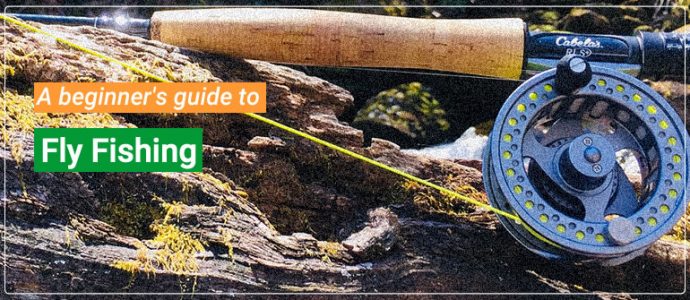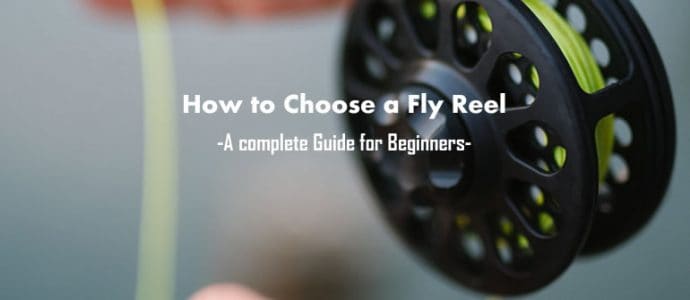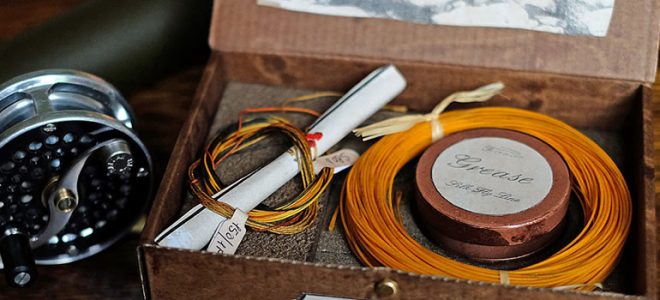If you buy via a link on this page, we may receive a commission, at no extra cost to you.Learn more
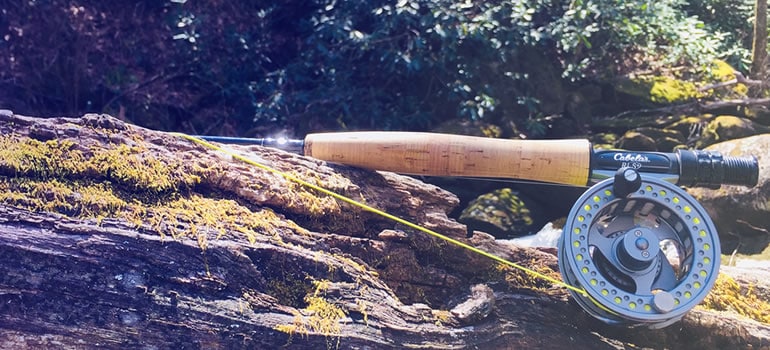
Although most people tend to take fly line leaders for granted, they are actually a very important part of the fly casting system. Thus, it is useful to be aware that not only do fly line leaders come in different lengths ranging from 6 ft. to 15 ft. with different tippet sizes ranging from 0X to 8X, there also different types of leaders and these different types perform differently from each other.
For instance, the most common type of fly line leader is the modern, extruded, Knotless Leader which is made from semi-liquid nylon and which is available from most any fly tackle dealer.
However, many experienced fly fishermen feel that knotted leaders work better than knotless leaders even though they are an older form of leader technology while, other fly fishermen have returned to even older technology in the form of braided and furled fly line leaders.
So, below you will find a description of each type of fly line leader as well as instructions on how to choose the right leader length and tippet size for the type of fly fishing that you intend to pursue.
The Purpose of a Fly Line Leader
So, why do fly fishermen attach a fly line leader to the end of their fly line? Well, as mentioned above, fly line leaders can take one of four different forms but, regardless of which type of fly line leader you choose, their purpose is to provide fly fishermen with a means to attach their flies to their fly line.
Also, the reason that fly line leaders are necessary is that, due to the manner in which fly lines are constructed, they have too large a diameter to enable them to thread the eye of a fly hook and thus, fly fishermen must attach a length of much smaller diameter line to the end of their fly line so that they can connect their fly to their fly line.
The Anatomy of a Fly Line Leader
But, before we examine the advantages and disadvantages of each type of fly line leader, it is first helpful to understand the anatomy of a fly line leader.
Thus, you first need to be aware that just like fly lines, fly line leaders are also tapered in order to transmit the energy stored and released by the fly rod during casting to the tip of the fly line and then on to to the tip of the leader in order to propel an artificial fly to its intended target.
Therefore, fly line leaders consist of a relatively thick “butt” section and then transition to a “taper” section and then to a “tippet” section. Thus, because of its larger diameter, the butt section of a fly line leader is attached to the fly line and the tippet section is attached to the fly.
Also, by varying the diameter of the butt, taper, and tippet sections, a fly leader manufacturer can create a relatively limber or relatively stiff fly line leader in order to enable fly fishermen to reliably cast different fly sizes.
Therefore, as it is when choosing a fly line, it is important to match the diameter of the tippet section to the range of fly sizes that you intend to cast in order to enable the leader to overcome the fly’s wind resistance and thus, straighten reliably.
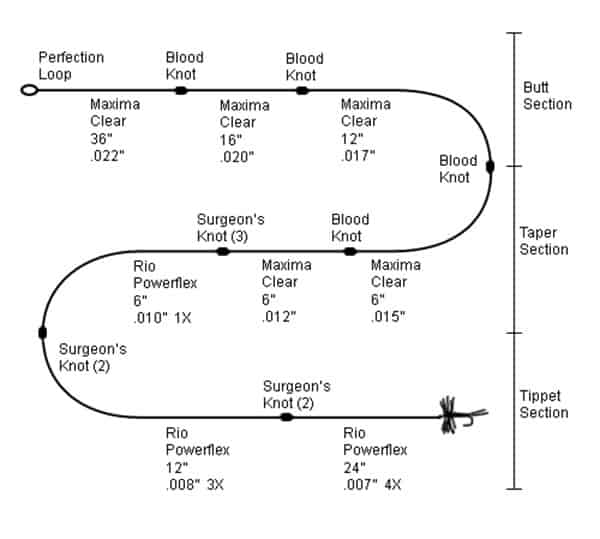
Fly Line Leader Designations
In addition, you also need to be aware that fly line leaders are commonly divided into freshwater leaders and saltwater leaders and that while freshwater leaders are designated by both their length and the diameter of their tippet sections, saltwater fly line leaders are commonly designated by their length and the tensile strength of their tippets.
However, it should also be noted that different manufacturer’s leaders have different tensile strengths and thus, that is why freshwater fly line leaders are designated by diameter instead of tensile strength.
Therefore, freshwater fly line leaders commonly range from 0X to 7X while saltwater fly line leaders commonly range from 8 lb. to 40 lb.
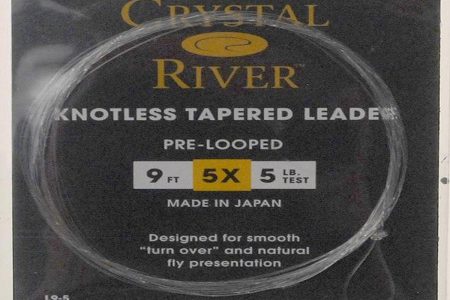
The Different Types of Fly Line Leaders
As mentioned above, there are four different types of fly line leaders and each type has both advantages and disadvantages.
For instance, the earliest form of fly line leaders were made from braided horse tail hair and were attached to braided silk fly lines. Thus, while braided leaders are no longer made from horse tail hair, they still have a small but dedicated following of fly fishermen because they are very easy to straighten and they also enable a fly fisherman to “turn over” exceptionally long tippets.
Consequently, some fly fishing equipment manufacturers such as Orvis still offer braided leaders made from nylon monofilament because they are far easier to construct than furled leaders and thus, much less expensive.
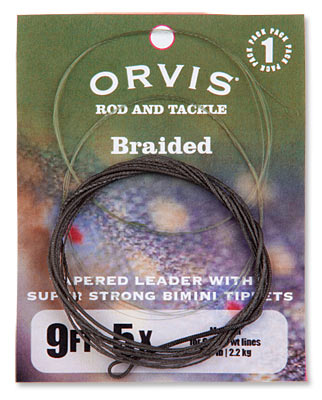
Next are furled leaders which are similar in construction to braided fly line leaders in that they too consist of multiple stands of leader material. But, unlike braided fly line leaders, furled leaders are much more difficult to construct because they require a specialized furling jig.
However, because furled fly line leaders have a significantly tighter weave than braided leaders do, they do not absorb and hold as much water as a braided leader does and thus, many experienced fishermen prefer furled leaders over braided leaders because they cause less spray when the fly line and leader are picked up off of the water’s surface on the fly fisherman’s back-cast.
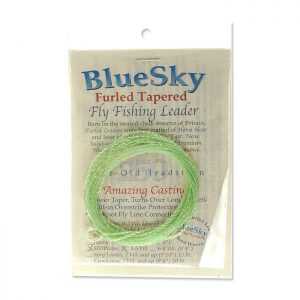
However, you should also be aware that while both braided and furled fly line leaders are tapered similar to knotted and knotless leaders, both braided and furled fly line leaders lack an attached tippet section because they are far less specific in their taper requirements.
Thus, after attaching a braided or furled leader to their fly line, fly fishermen then attach the length and diameter of tippet that they desire to the end of their leader. Furthermore, it should also be noted that because of their significantly larger diameter, both braided and furled leaders can be seen far more easily by the fish and thus, they require significantly longer tippets than either knotted or knotless leaders do.
Next in line is a somewhat newer form of fly line leader technology called a Knotted Leader. Thus, as the name implies, knotted fly line leaders are constructed from multiple pieces of level monofilament material of varying lengths and varying diameters which are tied together using blood knots.
However, even though knotted fly line leaders “turn over” and straighten far better than knotless fly line leaders do, some fly fishermen are opposed to using them because they feel that the knots make the leader more visible to the fish. Therefore, the vast majority of fly fishermen prefer knotless leaders instead.
Last, there are Knotless Leaders and, again as the name implies, a knotless fly line leader is made by heating nylon monofilament to the melting point and then extruding it through a die with a variable inside diameter so that the leader can be constructed to include a larger diameter butt section, a smaller diameter taper section and, an even smaller diameter tippet section just like a knotted leader does but, without the need for the knots.
Therefore, knotless fly line leaders are by far the most common and the least expensive type of fly line leader available and thus, they are also the most popular even though they are significantly more difficult to straighten while casting than braided leaders, furled leaders or, knotted leaders are.
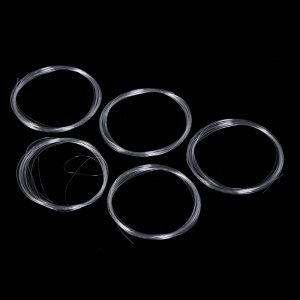
The Different Types of Fly Line Leader Materials
Now that you are aware that there are different types of fly line leaders, you also need to be aware that there are different types of leader materials. For instance, while most fly line leaders are made from nylon monofilament, some braided and furled leaders are made from nylon thread rather than nylon monofilament.
Thus, those that are made from nylon thread are often significantly more limber than those made from nylon monofilament and thus, they sometimes do a better job of transferring energy from the fly line to the tippet and thus, they often turn over and straighten more easily.
On the other hand, all knotted and knotless fly line leaders are made from either nylon monofilament or fluorocarbon monofilament with the major difference being that although nylon monofilament is translucent, it’s still visible to the fish whereas, fluorocarbon monofilament has the same refractive index as water and thus, fluorocarbon becomes nearly invisible when submersed in water. In addition, it should also be noted that nylon monofilament floats while fluorocarbon monofilament sinks.
Therefore, most experienced fly fishermen use fly line leaders made from nylon monofilament when fishing with flies that are designed to float on the water’s surface and fluorocarbon monofilament leaders when fishing with flies that are designed to sink beneath the water’s surface. However, because fluorocarbon fly line leaders are significantly more expensive than nylon leaders are, many fly fishermen use nylon leaders with all types of flies regardless of whether they are designed to float or sink.
How to Choose a Fly Line Leader
So, now that you are aware that there are different types of fly line leaders made from different types of materials and that both knotted and knotless leaders are designated by both length and tippet diameter, how do you choose the right length and tippet size for the fish that you intend to pursue?
Well, the answer to that question lies in the two charts displayed below. However, you should be aware that the information listed in the charts only applies to knotted and knotless fly line leaders and should only be used as a general guideline rather than a set of rules.
Leader Length Chart
| Leader Length |
Best suited for… |
|
6 foot |
Sinking and sink-tip fly lines of all types and for small, overgrown, streams. |
|
7.5 foot | Best for trout in streams from 10-30 feet wide and intermediate and sink-tip fly lines in lakes and saltwater where the fish are not too spooky. Also streamer fishing for trout with big flies or with heavy nymphs and big indicators. |
|
9 foot | Trout streams larger than 30 feet wide where the water is mostly riffled, or else the fish are not spooky. Also, the most popular salt water length when fish are in shallow water under bright, clear, light conditions. |
| 12 foot | Trout in most lakes with floating lines. Trout in streams with flies smaller than size 16 when the water is flat, low, or very clear. |
| 15 foot | Spooky trout in extremely clear water in both lakes and rivers. |
Tippet Size Chart
| Tippet Size | Tippet Diameter | Approximate breaking strength in (pounds) | Balances with fly sizes: |
| 8X | .003″ | 1.75 | 22, 24, 26, 28 |
| 7X | .004″ | 2.5 | 18, 20, 22, 24 |
| 6X | .005″ | 3.5 | 16, 18, 20, 22 |
| 5X | .006″ | 4.75 | 14, 16, 18 |
| 4X | .007″ | 6 | 12, 14, 16 |
| 3X | .008″ | 8.5 | 6, 8, 10 |
| 2X | .009″ | 11.5 | 4, 6, 8 |
| 1X | .010″ | 13.5 | 2, 4, 6 |
| 0X | .011″ | 15.5 | 1/0, 2, 4 |
| .012 | .012″ | 18.5 | 5/0, 4/0,3/0, 2/0 |
| .013 | .013″ | 20 | 5/0, 4/0,3/0, 2/0 |
| .015 | .015″ | 25 | 5/0, 4/0,3/0, 2/0 |
Conclusion
So, as you can see, the process of choosing the appropriate fly line leader is not nearly as complicated as the process of choosing a fly rod or a fly line but, even so, it still requires considerable thought from the fly fisherman.
However, while both braided and furled fly line leaders are specific to a particular range of fly line weights, both knotted and knotless fly line leaders are not line weight specific and thus, any knotless or knotted fly line leader can be used with any fly line.
Therefore, the process of choosing an appropriate fly line leader starts with choosing the type of leader that you prefer based on its performance. Then, if you choose to use knotted or knotless leaders over braided or furled leaders, you will need to choose the type of leader material that you prefer according to whether you intend to fish on the water’s surface or beneath it and then choose an appropriate leader length according to the degree of delicacy you require in your presentation as well as an appropriate tippet size to match the range of fly sizes that you will be casting with it.
However, because the different types of fly line leaders vary greatly in performance, you should experiment with the various different types in order to determine which type you prefer and then, once you settled on a particular type of fly line leader, then you can experiment with different lengths and tippet sizes.

